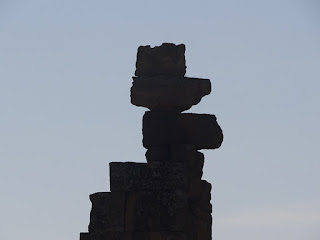Hi, In this post I'll start with a couple of images taken at Rumi's tomb and then move on to Cappadocia.
We stopped at the tomb during our trip from Antalya to Cappadocia. Rumi was a theologian and mystic who lived in the 13th century. He became an adherent of the Sufi sect of Islam and after he died his son and followers founded the Order of the Whirling Dervishes. Photography of the burial area is not permitted, however, there is a Mosque on the tomb grounds and
We stopped at the tomb during our trip from Antalya to Cappadocia. Rumi was a theologian and mystic who lived in the 13th century. He became an adherent of the Sufi sect of Islam and after he died his son and followers founded the Order of the Whirling Dervishes. Photography of the burial area is not permitted, however, there is a Mosque on the tomb grounds and
photography of the outside of the burial area is allowed.
We began our tour of Cappadocia the next morning with a stop at an overlook. It was interesting to see how homes had been built into the rocks. Scattered among the hoodoos (conical rock formations) were standard homes, businesses and Mosques. I don't know haw many hoodoos there are but I am sure they number at least in the hundreds.
This is a close up view of the mountain on the left side of the photo above. The windows and doors of homes carved into the rock can be seen more clearly.
Some of the formations looked like faces.
A church had been carved into the rock under this dome. When the rock failed and part of it split away the interior of the church was exposed to view.
The interiors of the rocks are honeycombed with tunnels and rooms. This reminded me of the Viet Cong tunnels in Viet Nam.
Circular stones were rolled across doorways and tunnel passages, and used as doors.
This rug seller was located in a small market.
Here is a different view of the mountain in the first Cappadocia photo.
In the next post I will conclude our visit to Cappadocia, including an early morning hot air balloon ride and a visit to a local school supported by the tour company. I hope you enjoyed the photos.
We began our tour of Cappadocia the next morning with a stop at an overlook. It was interesting to see how homes had been built into the rocks. Scattered among the hoodoos (conical rock formations) were standard homes, businesses and Mosques. I don't know haw many hoodoos there are but I am sure they number at least in the hundreds.
This is a close up view of the mountain on the left side of the photo above. The windows and doors of homes carved into the rock can be seen more clearly.
Some of the formations looked like faces.
A church had been carved into the rock under this dome. When the rock failed and part of it split away the interior of the church was exposed to view.
The interiors of the rocks are honeycombed with tunnels and rooms. This reminded me of the Viet Cong tunnels in Viet Nam.
Circular stones were rolled across doorways and tunnel passages, and used as doors.
This rug seller was located in a small market.
Here is a different view of the mountain in the first Cappadocia photo.
In the next post I will conclude our visit to Cappadocia, including an early morning hot air balloon ride and a visit to a local school supported by the tour company. I hope you enjoyed the photos.






















































